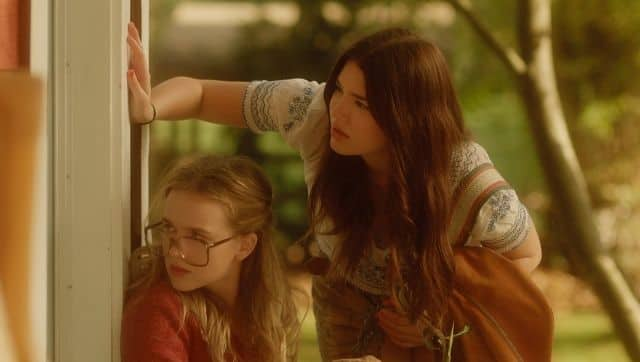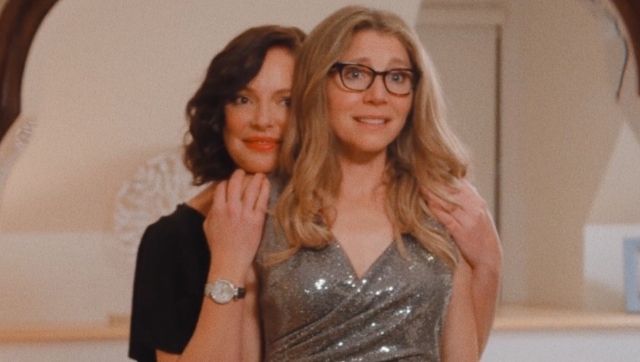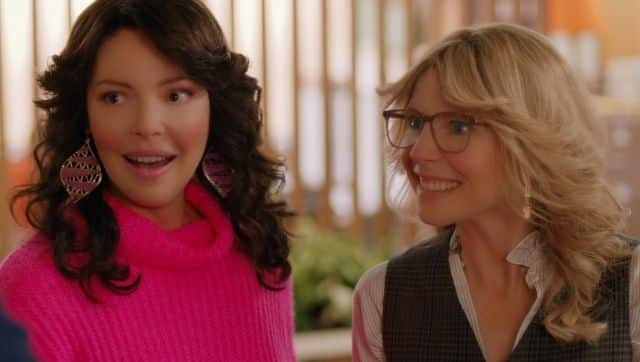The post-pandemic world has witnessed an enormous spike in content-viewing. More often than not though, viewers (like me), tuned into comfort watches, the kind The New Yorker writer Kyle Chayka described Emily in Paris as — “ambient TV”. Except, Emily in Paris had Paris’ breathtaking panoramic view and lead actor Lily Collins’ portrait of sartorial perfection going for it. Firefly Lane, Netflix’s latest offering starring Katherine Heigl and Sarah Chalke, doesn’t particularly know how to navigate its expansive and layered source material (The show is based on a novel of the same name by Kristin Hannah). Firefly Lane swings back and forth across several timelines to chart its protagonists Tully Hart (Heigl) and Kate Mularkey (Chalke)’s three-decade-long friendship, from teenagers, college-goers, interns at a local TV network set in the 1980s; their early 40s, set in the year 2003 to a final flash-forward to 2005. The non-linear narrative plays out like a montage of disparate episodes from their lives that have come to define their adult personalities. The show begins with Tully, a feisty teenager with major abandonment issues, moving in next door to Kate’s seemingly normal family in the Firefly Lane neighbourhood, thus establishing the significance of the title, the bedrock of their lifelong best-friendship. Tully’s absent, cannabis-addict mother forces her to seek out normalcy, something Kate’s family has in plenty to offer. [caption id=“attachment_9285141” align=“alignnone” width=“640”]  A still from Firefly Lane[/caption] Kate, on the other hand, has her own demons to fight. Shy and a stickler for rules, Kate is frequently ostracised by her peers. The vibrant Tully becomes her constant companion and the all-access card to social gatherings. Thus unite the yin and yan — but for life? That’s the overarching question creator Maggie Friedman toys with in the entire series. The show is predominantly a feel-good drama, but each episode ends with a cliffhanger (that may or may not be misleading). Unfortunately, despite the experimental editing schtick, all the intrigue fail to inject the storyline with one twist that can’t be foreseen from over 100 kilometres away. The question then, is, did Firefly Lane really need the dramafication? The portions about teenager Tully and Kate (played by Ali Skovbye and Roan Curtin, respectively) are genuinely heartwarming. There’s nothing that we’ve not seen before — be it the saviour friend taking down bullies or the popular friend befriending jerks to prove a point to their mother, or the teenage angst. But it’s the regularness of their conversations, the familiar set-pieces from comedies on female friendships that genuinely tug at your heartstrings. You’re invested when Tully lies to Kate about her mother having cancer, because she’s mighty embarrassed of her mother. You root for Tully when she resolves to attack her rapists’ head with hair removal cream, but freezes when she sees him gleefully hanging out with his sniggering male friends. [caption id=“attachment_9285161” align=“alignnone” width=“640”]  Katherine Heigl and Sarah Chalke in Firefly Lane[/caption] But it seems Friedman has an affinity for soapy melodramas, with an overdose of schmaltz and saccharine. From molestation, bullying, familial discord, divorce, pregnancies, funerals and even the death of a dog, Friedman leaves no stones unturned to extract a tear or two. It could’ve worked, but for its commitment to land the punch, whizz past to different decade style. The timelines get increasingly convoluted, never offering viewers enough time to process their emotions. This seems strange since Firefly Lane spends enough time developing its characters. But each episodic nugget is too brief, too impactless to come together as a whole. Firefly Lane could very well have been an anthology of friendship tales about different people. The only common factor that binds the show, thus, are the characters of Tully, Kate and Johnny Ryan (Ben Lawson), Kate’s husband and the producer of Tully’s show The Girlfriend Hour in the 2003 timeline. But it’s a burden that none of the adult actors is able to shoulder successfully. Heigl, who has previously aced the role of the affable woman steadfastly focused on her career, is nauseatingly garish to seem like a human. Tully’s fraught relationship with her mother, elaborately played out in almost every episode, has turned her into a shell of a person. But Heigl’s portrayal is painfully one-note as the adrenaline-pumped, snarky talk-show host to effectively communicate Tully’s crippling sense of emptiness and fragility. Chalke’s Kate is comparatively more holistic and restrained, and her relationship with her teenage daughter is as troubled as is it tender. But both Tully and Kate’s graduation to adulthood isn’t consistent enough to come across as one singular character. [caption id=“attachment_9285121” align=“alignnone” width=“640”]  The 80s segments are particularly jarring[/caption] What’s more, the 80s segments are specifically inauthentic and jarring to the senses. With obnoxiously coiffed wigs, exaggerated costumes and makeup, it ends up seeming more like a parody of the generation than a sincere depiction. More unsettling is the almost-greasy filter used to blur out Heigl and Chalke’s faces, presumably to make the actors look appropriately 20-somethings. Rest assured, it can effectively put Instagram’s filter library to shame. To add a cherry to the cake, you may also find Heigl exclaiming “because it’s the 80s, baby” at unexpected moments as a routine reminder of the era, in case anybody, absolutely anybody, miss the markers. Conversely, the 2003 timeline has no markers to indicate the period to be any different from 2021, except for a sequence where Tully unveils the flip-phone with an additional camera feature [gasp], or the fleeting mentions of MySpace, American Idol or the 9/11 attacks. The tonal inconsistencies make the transitions from one period to another significantly wobbly, shaking off any suspension of disbelief that you might achieve. Despite its glaring shortcomings though, Firefly Lane is immensely bingeable. It has enough things happening at once to hold your attention, but its mosaic structure with familiar stories of sisterhood gives you liberal leeways to get engrossed in Candy Crush marathons or online retail. It is the perfect ambient show, with generous giggles, snorts and laughs, that conjures a semblance of lazy comfort in such distressing times. Like an unsalted bag of popcorn, that you inadvertently gobble up during a heated episode of Keeping Up With The Kardashians, but don’t particularly remember having. Rating: 2.5 out of 5 Firefly Lane is now streaming on Netflix. All images from Twitter
Some genuinely heartwarming moments aside, Firefly Lane is like an unsalted bag of popcorn, that you gobble up during a heated episode of Keeping Up With The Kardashians, but don’t particularly remember having.
Advertisement
End of Article
Written by Pratishruti Ganguly
Square peg in a round hole (or something else that's equally cliché), bad punner and worse poetess see more


)
)
)
)
)
)
)
)
)



